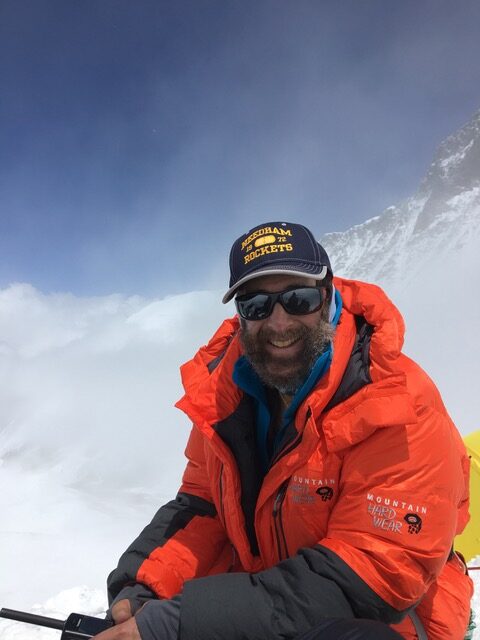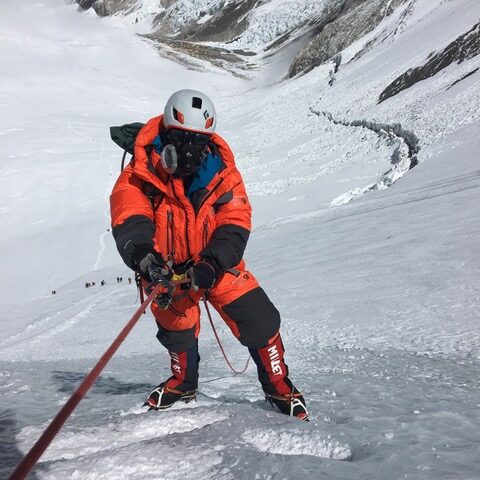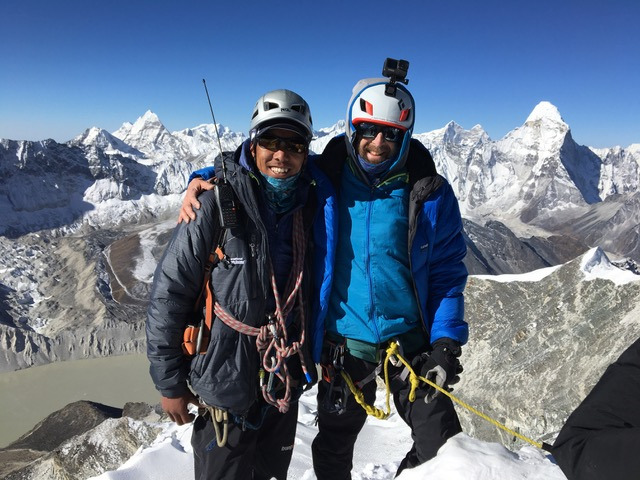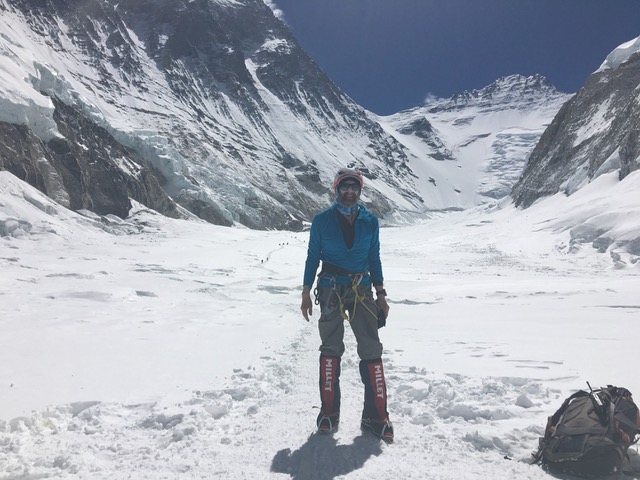How the retired physician Jonathan Sugarman made it to Camp 3 on Everest despite a pre-trip forced layoff.

Note: We recently received word that Dr Jonathan Sugarman died on Monday while attempting to climb Mount Everest with a Washington-state guiding service. While we were not working with Jonathan for the past year we previously had worked with him for 3 years. We knew him as a good, earnest guy. He was humble and he really cared about the Sherpa people. He also had a whimsical side. He brought a plastic trumpet to basecamp to practice! In Jonathan’s memory please remember to be grateful and loving to those around you. -The Uphill Athlete Team.
(Published in August 2022) When Jonathan Sugarman went to Nepal in spring 2022, he wasn’t sure what to expect. His goal was to climb a couple of trekking peaks, then see how high he could get on Mount Everest. But the last time he’d been at altitude, it hadn’t gone well. In 2016, despite no previous issues with altitude sickness, Sugarman—a retired physician based in Seattle who’d come back to climbing in his fifties after leaving it behind in college—came down with high-altitude pulmonary edema (HAPE) at Camp 1 (~6,400 meters) on Cho Oyu and had to abort his climb. Curious to see if he could climb at altitude again—and push to a target goal of 7,000 meters—Sugarman began to plan a trip to Nepal. He had a good fitness base from his nine years of working with an outdoor-athlete-focused coach, but he felt like he needed something more.
Sugarman, 68, had read Training for the New Alpinism and decided to purchase a training plan from Uphill Athlete; in July 2021, he began to work with an Uphill Athlete coach. All was going well—quite well, in fact: “Jonathan was nothing special in terms of being unfit or fit,” said his coach “However, we saw him double his work capacity at his aerobic threshold after about six months of training.” Then Sugarman got injured, twice, and had to pull back. In mid-January 2022, a sudden onset of hip/pelvic-girdle pain sidelined him for two weeks, limiting him to a small amount of core and upper-body work, as well as some light swimming and stationary biking. Then, in February, he pinched a nerve in his neck, resulting in arm pain and numbness when he looked up (a key body position for any climber!). Sugarman stuck with a scheduled ice-climbing trip to Ouray, but found himself nearly nonfunctional on the ice, and was no longer able to train core or do upper-body work due to pain and related limitations.
“I was pretty much on a day-by-day basis and could only tolerate relatively brief walks for a couple of weeks, but nothing near what should have been a pretty high-intensity consolidation of training during the last six weeks before my trip [to Nepal],” he says. Nonetheless, he stuck with his plans to go to Nepal. In April, having recovered from his neck injury, Sugarman climbed Lobuche (6,119 meters) and Island Peak (6,160 meters) without any issues; on May 8, he made it to Camp 3 (7,300 meters) on Everest, using bottled oxygen on the long climb up the Lhotse Face from Camp 2.

One key takeaway from Sugarman’s story is the remarkable staying power of a carefully developed aerobic foundation—i.e., the power of a good base. Sugarman had—as so many athletes do—initially questioned UA’s slow, graduated approach to training. “Although I understood intellectually the value of low-intensity (Zone 2) training, it was a challenge to slow down enough to maintain my heart rate and level of exertion required by the Uphill Athlete approach,” he says. Yet the science bears this approach out.
In a nutshell, our body uses the energy-storage molecule adenosine triphosphate (ATP), synthesized from the food we eat, to fire muscular contractions. We produce ATP two ways: via the aerobic metabolic pathway and via the anaerobic metabolic pathway. Essentially, we use the aerobic pathway for low-intensity exercise, and once that intensity passes a certain point (the aerobic threshold, or AeT), we begin to switch to the anaerobic pathway, which creates the waste product lactate—bringer of the fatigue and burning muscles we’re all too familiar with. Thus the goal with UA’s approach is to increase the AeT, so that your body can operate as much as possible via the aerobic pathway and also become more efficient at flushing out lactate and other waste products when you do go anaerobic. As we write in “What Enables Endurance?”: “You have no doubt heard the various terms of adulation heaped on great endurance athletes: ‘So-and-so has a great aerobic base’ or ‘She has a really big motor.’ Well now you know what that refers to from a muscular and metabolic standpoint. Here is the counterintuitive rub: To improve your higher-intensity endurance, you must first make sure you have maximized the aerobic capacity of those unsexy low-intensity, low-power slow-twitch fibers.”

This is precisely what Sugarman did during his training with UA, putting in about 12 hours a week until he got injured. His home in Seattle put him within a 30- to 60-minute drive of a variety of conditioning hikes with 2,000 to 4,000 feet of elevation gain and various degrees of steepness. And he lives right on a park that has a trail with a 14 percent grade and 200 feet of gain where he’d huck multiple laps twice a week. And Sugarman set up a training space in the back of his garage, where he did strength training—particularly the core exercises described in Training for the New Alpinism. He also worked with the UA nutritionist Rebecca Dent on his diet.
Sugarman saw results: In November 2021, he took a trip to Ecuador, where he easily summited Cotopaxi (5,897 meters) and got high on Cayambe (5,790 meters) and Chimborazo (6,263 meters) before the team turned back due to avalanche. After the trip, “I felt fit and confident that I’d be prepared for Nepal,” he says. And while the two back-to-back injuries sidelined him, the sum total of Sugarman’s training ended up having remarkable staying power in Nepal, where the trek in to Everest Basecamp also helped provide an excellent acclimatization schedule.
We caught up with Sugarman for a brief Q & A.
Uphill Athlete: Tell me a little about how you got into climbing.
Sugarman: I climbed when I was in college, but quit cold turkey when I found myself doing something that had resulted in recent deaths and I realized that I was not appropriately concerned. I dragged around a climbing rope, harness, and rack for years, though. When I was in my fifties, my college roommate invited me to travel to Tanzania (where he was picking up his son from a stint working in an orphanage) and to climb Kilimanjaro. Although I wasn’t initially inclined, my daughter (then in college) asked if she could come too, and that sealed it. That led me to climb Mount Rainier a short time thereafter, to join the Mountaineers in Seattle, and to take a couple of climbing courses—and then embark on a number of domestic and international climbs
UA: Why did you reach out to Uphill Athlete?
Sugarman: In 2016, despite never having had altitude issues previously, I experienced an unfortunate episode of high-altitude pulmonary edema at Camp 1 on Cho Oyu. Fast-forward a couple of years and a few more expeditions, and I thought it might be worth an experiment to see if HAPE was an inevitable consequence of returning to similar elevations, so I began to plan for a trip to Nepal with International Mountain Guides, to see if I could climb to 7,000 meters. I had been working with an excellent outdoor-athlete-focused coach for nine years, which definitely contributed to my fitness and supported my climbing goals. But I wasn’t sure I was progressing, particularly with regard to endurance.
UA: How did UA customize the training for your goals, and how did you measure progress as you went?
Sugarman: In addition to completing the aerobic threshold test under the guidance of Seth Keena-Levin, I underwent metabolic-efficiency testing shortly after beginning the program. While the workout schedule Seth prepared was generally consistent with the packaged course, it was definitely customized to my goals and progress through almost daily review and feedback. When the metabolic-efficiency test was repeated four months later, it showed that I was able to sustain a much higher workload and intensity at a lower heart rate compared to the start of the training. That objective evidence supplemented the subjective sense I had of improved endurance and overall fitness.
UA: How did you get injured, and how did that affect your ability to prepare for Nepal?
Sugarman: I actually had not one but two unrelated injuries leading up to the trip. In mid-January, I had to abort a workout due to acute onset of hip/pelvic-girdle pain. That resulted in a two-week pullback during which I couldn’t hike or even do much walking, although I continued with a little core and upper body work, as well as some low-intensity stationary-bike work and lap swimming. But shortly after I was able to restart hiking in early February, I sustained an injury that turned out to be caused by a pinched nerve in my neck resulting in cervical radiculopathy. The symptoms started shortly after an overhead-pulling workout. I was in significant discomfort almost continuously (couldn’t look up without arm pain and numbness, and couldn’t do any core or upper-extremity exercise). I carried through with a scheduled ice-climbing trip to Ouray at the end of February, and it didn’t go very well. After an MRI clarified what was going on, I considered canceling the Nepal trip but decided to hold off as long as possible.
UA: Any standout moments from your trip?

Sugarman: I summited Lobuche and Island Peak, along with my guide Kunga G. Sherpa from Pangboche. Both were fun, and gave me confidence that I was fit enough to navigate the Khumbu Icefall. Traveling through the icefall was amazing, but thanks to adequate fitness and my excellent guide on Everest, Fura Jangbu Sherpa from Pangboche, I landed at Camp 1 no worse for the wear. I was overcome with emotion to actually be looking at the Western Cwm, Lhotse, Nuptse, and Everest IRL instead of just in pictures. The walk to Camp 2 was pretty straightforward and uneventful. I used oxygen from Camp 2 to Camp 3 on the Lhotse Face—which was probably a good thing, because even with the O2 the 4.5-hour walk took a fair amount of effort. To be honest, I was never sure until I got there that I’d actually make it to Camp 3, so I had a nice sense of accomplishment when I arrived.
In some ways, my hardest day was the descent from Camp 2 to Everest Basecamp the following day. Due in part to a lot of noise from an adjacent camp, I hardly slept a wink. Whatever fitness reserves I had were pretty much exhausted, and I knew as much before I left Camp 2, where I told my guide that it was going to be a long day. In retrospect, I wonder whether this is where the training gap in the month or so before I left for Nepal showed itself.

